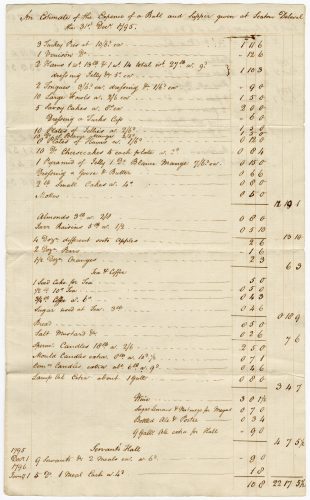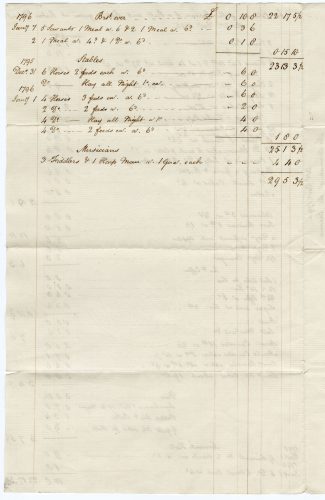Planning a ball with the Delaval family
COSTS FOR A BALL, 31ST DECEMBER 1795, REFERENCE: 2DE/30/15/5A&B
THE DELAVAL FAMILY
The Delaval family lived at Seaton Delaval in south east Northumberland but also had estates in the late 18th century at Ford (North Northumberland) and Doddington (Lincolnshire). At this time the 1st Baron Delaval, John Hussey Delaval was living at Seaton Delaval Hall. He was involved in politics and for various periods between 1754 and 1786, he was an MP for Berwick. The family were renowned for their parties and lavish entertaining at Seaton Delaval Hall.
The family relationships can be seen in the Delaval family pedigree.

💡What kind of parties do you think the Delaval family hosted?
💡How different do you think they were from parties today?
🌍 Did you know, you can visit Seaton Delaval Hall. What could you find out about their notorious parties and pranks?
📚Try reading the document. Can you pick out some of the items bought for the ball?
🗣 Read the document out loud. Does this make it easier to understand?
SEATON DELAVAL HALL NEW YEAR’S EVE BALL
This document is an estimate of the expenses for a Ball and Supper held at Seaton Delaval Hall on New Year’s Eve in 1795. The financial account doesn’t tell us how many people were there but some of them must have brought their servants and stayed overnight as the record shows meals for servants and hay for horses.
The food listed helps us see what was served at a large supper at a Ball in the late 18th century. There must have been a large buffet consisting of various pies (turkey) and meats (venison, ham and tongue), probably cold because of the reference to jelly.

There were also sweet dishes including savoy cakes, cheesecakes and small cakes as well as a variety of fruits – almonds, raisins, apples pears and oranges. The guests were also offered wine to drink as well as tea and coffee, bottled beer and porter. The ingredients for a drink called “Megus” are also listed, some form of cocktail which included lemons, sugar and nutmeg. This may be the 18th century drink “Negus” which was wine mixed with hot water, lemons, spices and sugar.
Music for dancing was provided by 3 fiddlers and a harpman who were paid one guinea each and even the cost of the lighting is added in – candles and whale oil for larger lamps.
In total the estimated cost for the ball was £29 5s 3 ½d, equivalent to £2,246-54 in 2017 and equivalent to 195 days wages of a skilled tradesmen in 1795. Unfortunately, there isn’t a list of who attended.
💡How different does the ball sound to how you spend New Year’s Eve?
💡Do you think the ball would have been more expensive today or in 1795?
💡 How do you think people travelled to the ball? Why is there hay for horses?
✏️ Imagine you’re going to host your own ball, come up with your own menu.
✏️ Can you come up with recipes for your buffet menu?
✏️ Create an invitation to your ball.
👩🍳Have a go at making some of your recipes.
SMALL CAKES
 The Delavals served “small cakes” at their New Year’s Eve ball. Here are three recipes for little cakes. The first is a 19th century recipe for “good” little cakes, where different seeds can be added. The second and third recipes appear in Hannah Glasse’s cookery book ‘The Art of Cookery made Plain and Easy’ published in 1747.
The Delavals served “small cakes” at their New Year’s Eve ball. Here are three recipes for little cakes. The first is a 19th century recipe for “good” little cakes, where different seeds can be added. The second and third recipes appear in Hannah Glasse’s cookery book ‘The Art of Cookery made Plain and Easy’ published in 1747.

👩🍳Have a go at making your own little cakes, you could use one of these recipes to inspire you. You might need to decrease the ingredient quantities! You could try adding other ingredients like spices, nuts, fruit or chocolate. You could even decorate them. Are they good? Would you serve them at your ball?
✏️Have a go at writing a recipe for your little cakes, you could include quantities and cooking instructions.



